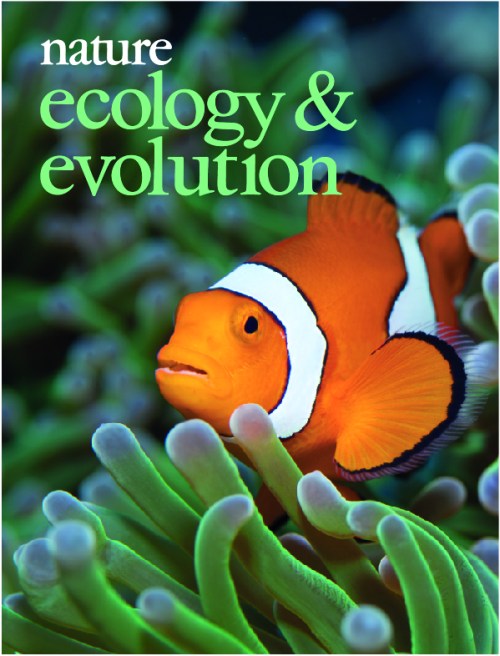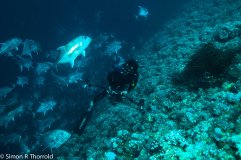April 11, 2018 9:18 pm
Better late than never – some lab highlights from 2017:
A paper dedicated to our dear friend and colleague Glenn Almany tracking larval dispersal of two species of coral reef fishes in Papua New Guinea:
https://www.nature.com/articles/s41559-017-0148
Feature article in Marine Ecology Progress Series from Greg Skomal and our lab describing movements of white sharks in the North Atlantic, documenting remarkable coastal and oceanic migrations of adults:
http://www.int-res.com/articles/feature/m580p001.pdf
New research using stable isotopes of amino acids to track the movements of penguins across ocean basins around Antartica from Michael Polito and co-authors:
http://rsbl.royalsocietypublishing.org/content/13/8/20170241
And finally a return to otolith geochemistry and an application tracking the movement of smallmouth bass in a Virginia river by Robert Humston and co-authors:
https://onlinelibrary.wiley.com/doi/full/10.1111/jfb.13073

December 16, 2016 3:49 pm
Some publication highlights from the lab in 2016:
The first genealogy for a wild marine fish population by Océane Salles and wo-workers published in Proceedings of the National Academy of Sciences
http://www.pnas.org/content/113/46/13245.full?sid=249a045b-473e-421a-ab08-bd4ca52f7795
Description of the population structure of a whale shark aggregation that we discovered in the Saudi Red Sea by Jesse Cochrane and colleagues published in the Journal of Fish Biology
http://onlinelibrary.wiley.com/doi/10.1111/jfb.13054/full
Estimates of regional variation in otolith geochemistry of juvenile Atlantic cod from Newfoundland published in the Canadian Journal of Fisheries and Aquatic Sciences by Ryan Stanley and co-authors
http://www.nrcresearchpress.com/doi/pdf/10.1139/cjfas-2015-0353
And the first visualization of coral reef food webs using stable carbon isotopes in essential amino acids published in Oecologia by Kelton McMahon and colleagues, including a great cover shot by Tane Sinclair-Taylor
http://link.springer.com/article/10.1007/s00442-015-3475-3/fulltext.html

January 6, 2015 7:06 pm
A new study, led by Prof. Pablo Saenz-Agudelo at the Austral University of Chile, reveals the importance of large females, and stable breeding pairs, to a population of panda clownfish (Amphiprion polymnus) in Bootless Bay, Papua New Guinea. Newly-settled juveniles were assigned to parents in the focal population using DNA parentage analysis. We found that large females do indeed contribute disproportionately to local population replenishment, providing further support for efforts to protect large females within fished populations. And interestingly, stable breeding pairs were also more successful than new pairs in which the original male had died. Read more here:

Photo Serge Planes
http://goo.gl/c3qczo
August 11, 2014 7:01 pm
 Just out, a new paper from the Fish Ecology Lab and collaborators describing a new aggregation site for juvenile whale sharks in the southern Red Sea. Interestingly, the sex ratios of the sharks we encountered was approximately 1:1, unlike all other aggregation sites that are dominated by males. We don’t understand the significance of the relatively high numbers of juvenile females in the Red Sea aggregation yet, but it does highlight the potential importance of this site to whale shark populations in the Indian Ocean and possibly beyond. Check out the paper (open access at PLoS ONE) using the URL below:
Just out, a new paper from the Fish Ecology Lab and collaborators describing a new aggregation site for juvenile whale sharks in the southern Red Sea. Interestingly, the sex ratios of the sharks we encountered was approximately 1:1, unlike all other aggregation sites that are dominated by males. We don’t understand the significance of the relatively high numbers of juvenile females in the Red Sea aggregation yet, but it does highlight the potential importance of this site to whale shark populations in the Indian Ocean and possibly beyond. Check out the paper (open access at PLoS ONE) using the URL below:
goo.gl/RmYKF1
The WHOI press release accompanying the article is here:
goo.gl/YsZAR6
July 1, 2014 7:21 pm

Photo: Nuno Sá
A new paper from the Fish Ecology Lab and collaborators has documented the remarkable diving abilities of Chilean devil rays (Mobula tarapacana) in the central North Atlantic. Dive profiles revealed that the rays are diving to depths of almost 2 km where they are encountering water temperatures as low as 3 degrees C. The rays were instrumented with pop-up satellite archival transmitting (PSAT) tags on Princess Alice seamount in the Azores. While definitive evidence is lacking, we assume that the rays are diving to forage on meso- and bathypelagic fishes that are abundance at depth in the central North Atlantic. Check out the paper (open access) here:
http://www.nature.com/ncomms/2014/140701/ncomms5274/full/ncomms5274.html
Aside
April 7th, 2014
Camrin and Simon back from a few days in the Farasan Banks, Saudi Arabian Red Sea. We took a break from tagging mantas and whale sharks to dive on reefs that were made famous by Jacques Cousteau 50 years ago. The reefs are still in good shape, although the lack of reef sharks is in stark contrast to Cousteaus’s original underwater footage from this area. More soon on a whale shark aggregation that we have discovered here in the southern Red Sea and why it is potentially significant to whale shark populations throughout the global ocean.


∞
Aside
March 4th, 2014
Camrin Braun has a new paper out in PLoS ONE on the diving behavior of reef mantas in the Saudi Arabian Red Sea. The data comes from pop-up satellite archival transmitting (PSAT) tags that have revolutionized our understanding of the vertical and horizontal movements of large ocean animals over the last 15 years. You can check it out here:
Diving behavior in Manta Rays – Braun et al.
The work was conducted as part of Cam’s Master’s thesis work while at the King Abdullah University of Science and Technology (KAUST), working with Prof. Michael Berumen. More to come on these fascinating rays soon!
 ∞
∞
Aside
January 25th, 2014
Li Ling Hamady successfully defended her PhD thesis the MIT/WHOI Joint Program in Oceanography – congratulations!! She also has just published a paper in PLOS ONE on extreme longevity in northwest Atlantic white sharks that you can check out here:
http://www.plosone.org/article/info%3Adoi%2F10.1371%2Fjournal.pone.0084006
The article has attracted a lot of interest from the media, including this report from the BBC –
http://www.bbc.co.uk/news/science-environment-25655666 ∞
∞











